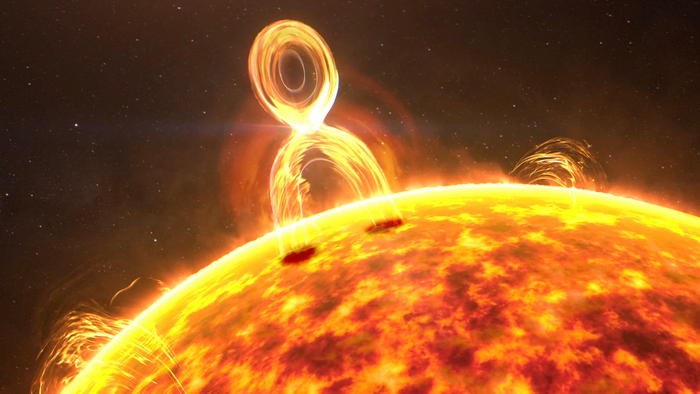To better understand the mechanisms underlying the fundamental astronomical phenomenon known as magnetic reconnection, scientists recreated small solar flares using twelve powerful lasers.

Screenshot from NASA’s Conceptual Image Lab on “Magnetic Reconnection Throughout the Solar System.” Magnetic reconnection occurs when anti-parallel magnetic fields—in this case found in solar flares—collide, break, and realign. The process produces a high-energy explosion that flings particles across space. Image Credit: NASA Conceptual Image Lab
The universe is anything but “the vast emptiness of space,” despite how familiar the phrase is. Although it might appear that celestial objects are few and far between, the universe is actually teeming with a variety of materials, including charged particles, gases, and cosmic rays.
The phenomenon of magnetic reconnection is one such force that propels particles and energy through space. Magnetic reconnection, as its name implies, occurs when two anti-parallel magnetic fields, i.e., magnetic fields moving in opposite directions, collide, split apart, and realign. Even though it sounds simple, the process is anything but calm.
This phenomenon is seen everywhere in the universe. At home you can see them in solar flares or in Earth’s magnetosphere. When a solar flare builds up and appears to ‘pinch’ out a flare, that is a magnetic reconnection. In fact, auroras are formed as result of charged particles expelled from the magnetic reconnection in Earth’s magnetic field.
Taichi Morita, Study First Author and Assistant Professor, Faculty of Engineering Sciences, Kyushu University
Nevertheless, many of the mechanisms underlying the phenomenon remain a mystery despite its frequent occurrence. Studies are being done, such as in NASA’s Magnetospheric Multiscale Mission, where satellites sent into the Earth’s magnetosphere are used to study magnetic reconnections in real time.
The rate of reconnection and the manner in which the magnetic field’s energy is transformed and distributed among the plasma’s particles are still unknown.
An alternative to launching satellites into orbit is to create magnetic reconnections with laser-induced plasma arcs. The generated plasma is too small and unstable to accurately study the phenomenon without a suitable laser strength, though.
Morita added, “One facility that has the required power is Osaka University's Institute for Laser Engineering and their Gekko XII laser. It is a massive 12-beam, high-powered laser that can generate plasma stable enough for us to study. Studying astrophysical phenomena using high-energy lasers is called ‘laser astrophysics experiments,’ and it has been a developing methodology in recent years.”
The high-power lasers were used in their experiments, which were published in Physical Review E, to produce two plasma fields with anti-parallel magnetic fields. The team then directed a low-energy laser into the plasma’s core, where the magnetic fields would theoretically collide and magnetic reconnection would take place.
Morita continued, “We are essentially recreating the dynamics and conditions of a solar flare. Nonetheless, by analyzing how the light from that low-energy laser scatters, we can measure all sorts of parameters from plasma temperature, velocity, ion valence, current, and plasma flow velocity.”
One of their key discoveries involved observing the emergence and disappearance of electrical currents at the points where the magnetic fields collided, which suggested magnetic reconnection. They were also able to gather information about the plasma’s heating and acceleration.
The group intends to continue its analysis in the hopes that these “laser astrophysics experiments” will be more frequently used as an additional or alternative method to study astrophysical phenomena.
“This method can be used to study all sorts of things like astrophysical shockwaves, cosmic-ray acceleration, and magnetic turbulence. Many of these phenomena can damage and disrupt electrical devices and the human body. So, if we ever want to be a spacefaring race, we must work to understand these common cosmic events,” Morita concluded.
Journal Reference
Morita, T., et al. (2022) Detection of current-sheet and bipolar ion flows in a self-generated antiparallel magnetic field of laser-produced plasmas for magnetic reconnection research. Physical Review E. doi:10.1103/PhysRevE.106.055207.